使用mininet快速入门ONOS路由交换技术与原理
在SDN下路由交换与传统硬件集成方式的路由交换技术有许多相似之处。其中一个比较重要的点是传统交换机中ASIC (Application Specific Integrated Circuit,专用集成电路)决定了其数据平面所支持的功能,而在SDN中,实现了控制面与数据面的分离。
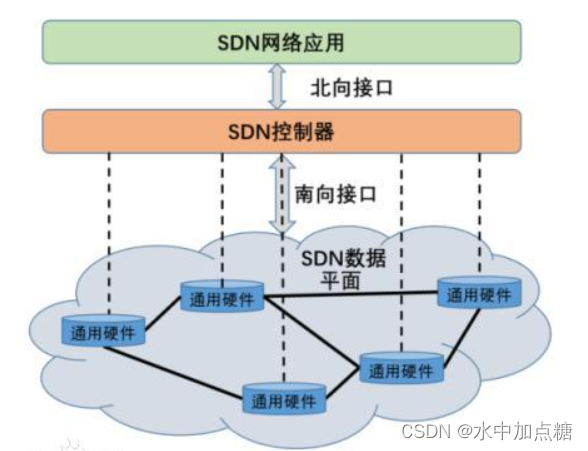
这里通过一个小示例来体验下SDN下两个主机通信的过程。
环境介绍

环境信息:
- onos-2.7.0
- mininet+ovs+openfllow
- idea
控制器-onos启动
SDN中的控制器很多,这里选择的是最新版本的onos,关于onos的入门编译教程可移步笔者的另一篇文章SDN控制器-ONOS源码编译与mininet快速入门
本地方式运行
onos支持多种方式运行,如为了调试与修改源码方便,可以直接在IDEA中运行onos,使用如下命令:
bazel run onos-local – clean debug
如由于网络原因导致无法编译,也可使用配置代理的方式运行onos
bazel run onos-local --action_env=HTTP_PROXY=$http_proxy – clean debug
启动成功后输出的样子如下:

关于如何在idea中调试onos可参考官方文档Using an IDE with ONOS 1.14 or higher (Bazel build)
docker方式运行
如果仅需要快速运行ONOS,可直接使用官方的docker方式运行,官方链接地址为:https://hub.docker.com/r/onosproject/onos
运行命令可参考如下:
docker run -d --network=host -e TZ=Asia/Shanghai --name onos onosproject/onos:2.7.0
这里为了方便将容器网络设置为了主机网络,可能占用的端口有:
- 8181 for REST API and GUI
- 8101 to access the ONOS CLI
- 9876 for intra-cluster communication (communication between target machines)
- 6653/6633 optional, for OpenFlow
- 6640 optional, for OVSDB
WEB验证
启动完成之后访问web控制台验证一下
浏览器中访问:http://127.0.0.1:8181/onos/ui ,输入用户名和密码karaf/karaf,随便点几个按钮看看。


当没有设备连接时,拓扑图也是空的,如上图所示,一切正常。
mininet运行
控制器就绪后,就可以让连了主机的sdn交换机连到控制器上去了。
为了方便,此部分使用模拟器方式来完成。(关于mininet的详细信息可访问mininet的官网:https://mininet.org/)
miniedit介绍
mininet提供了多种方式模拟openfllow交换机与主机,如命令行和python脚本方式。另外还可使用mininet源码中的miniedit构建需要模拟的拓扑信息,miniedit软件截图如下:


如要使用miniedit,可将mininet代码clone,https://github.com/mininet/mininet.git,运行对应位置的miniediy.py即可。miniedit位于mininet的examples目录下:

mininet安装
这里为了方便就直接使用命令方式了。以ubuntu系统为例,安装步骤如下:
#安装mininet
sudo apt-get update
sudo apt-get install mininet bridge-utils
#查看mininet版本
mn --version
安装好后使用mn随便运行一下,没有报错就代表mininet安装成功啦
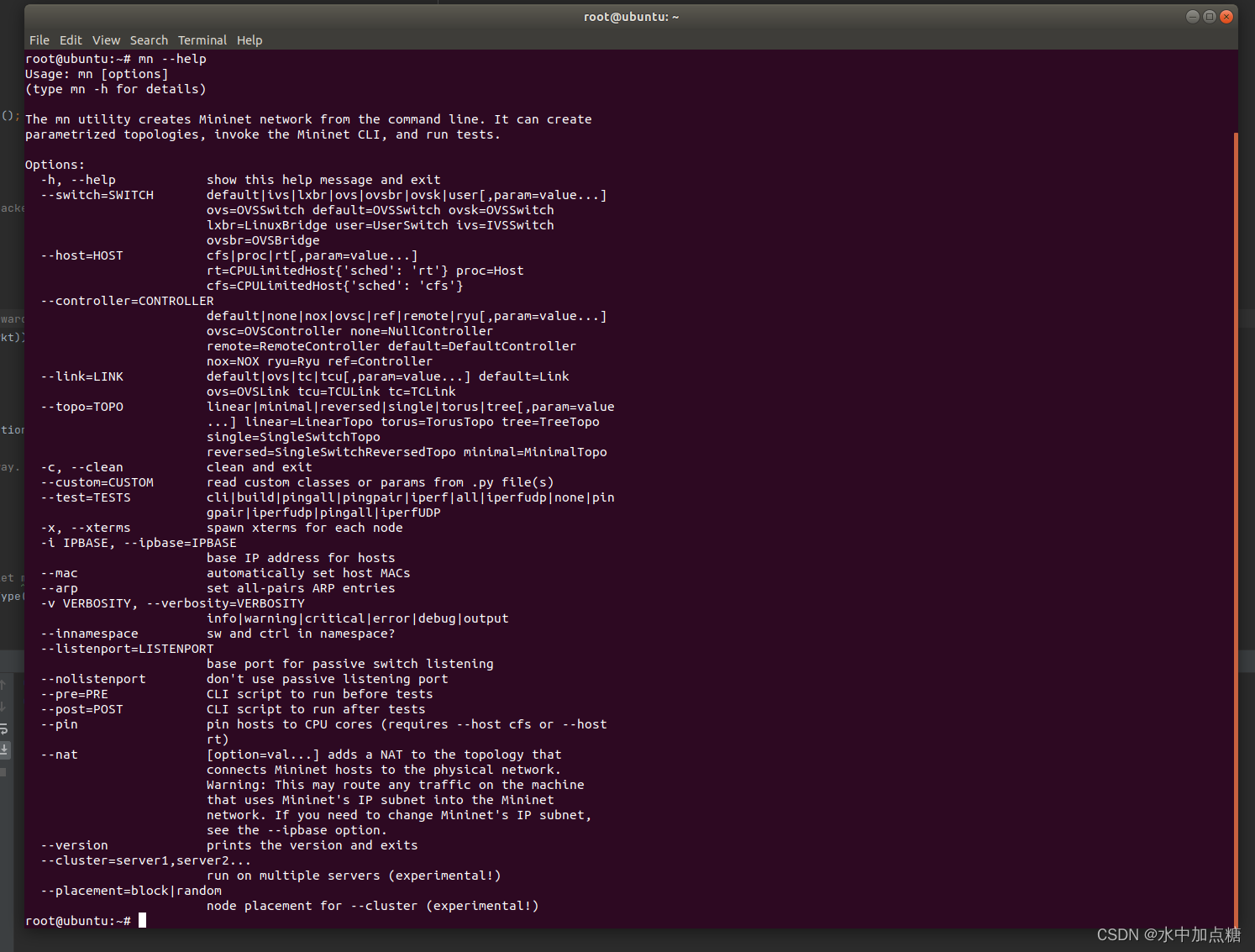
mininet常用命令
nodes查看可用节点

c代表controller
h代表host
s代表switch
dump命令输出每个node的具体信息

使用links查看各node的连接信息

dpctl-数据面控制器,支持的命令比较多可以使用dpctl --help查看一下

如导出交换机的流表信息使用如下命令
dpctl dump-tables
导出表项信息使用如下命令
dpctl dump-flows
控制器openflow应用启动
一切就绪后,开始启动onos中自带的openflow应用。在Applications菜单中找到org.onosproject.openflow包,点击运行即可:

也可使用ssh输入app activate命令进行启动:
app activate org.onosproject.openflow
openflow应用启动成功后会占用6653和6633端口以等待openflow交换机连接的到来

运行mininet
最后一步,运行mininet连接到控制器。搞一个默认最简单的拓扑:
sudo mn --topo single,3 --controller remote,ip=127.0.0.1,port=6653 --switch ovsk,protocols=OpenFlow14
简化一点:
sudo mn --topo single,3 --controller remote,ip=127.0.0.1,port=6653
参数说明:
- topo=single,3为1台交换机下3个主机
- protocol=OpenFlow14为交换机使用openflow1.4协议
- switch ovsk为使用openvswitch交换机
- controller、ip、port参数指定了心中控制器的ip和端口(By default, --controller=remote will use 127.0.0.1 and will try ports 6653 and 6633)
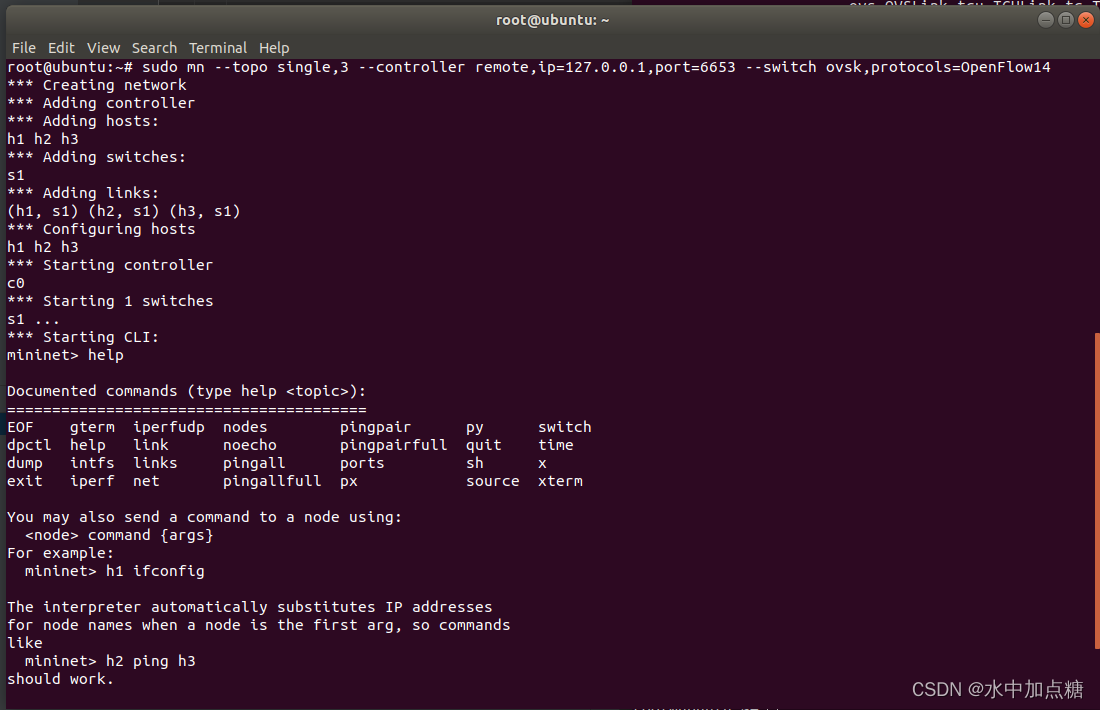
查看一下端口连接情况

回到中心控制器的界面上,显示设备在线就成功了

也可使用onos-cli中的devices命令可查看连到控制器中的设备信息

主机ping通
接下来进行通信部分:让交换机下的每个主机可相互通信。
在mininet中输入pingall命令验证一下。

包全丢了。再试一下单独让h1与h2通信,仍然不通

不可达分析
拿着当前拓扑图,一起回忆下大学时《计算机网络》中的知识点:位于同一网段的两个主机,使用交换机二层转发进行通信(mac地址)

也就是h1想要与h2通信,h1和h2必须知道双方的mac地址。如果不知道,就要发arp包学习对端的mac地址。
具体为:主机1向主机2发送icmp包之前查看本地arp列表,如未找到主机2的mac地址则需要发送arp广播包以获取到主机2的mac地址,当学到对端主机2的mac地址后再发送icmp包。
那么如何将h1发的arp包让交换机发给h2呢?答案就是下发表项,让交换机根据所配置的表项规则来指导数据的流转。
openflow包转发过程如下图:

具体如何下发呢?有多种方式,其中比较简单的是调用ovs交换机提供的命令进行下发。此处很幸亏的是,在onos的openflow应用中默认已经帮我们下发了arp这些基础表项了。
可以使用mininet中导出流表的命令查看一下当前设备的流表情况:
mininet> dpctl dump-flows
*** s1 ------------------------------------------------------------------------
cookie=0x100009465555a, duration=5653.523s, table=0, n_packets=0, n_bytes=0, priority=40000,dl_type=0x88cc actions=CONTROLLER:65535
cookie=0x100007a585b6f, duration=5653.523s, table=0, n_packets=0, n_bytes=0, priority=40000,dl_type=0x8942 actions=CONTROLLER:65535
cookie=0x10000ea6f4b8e, duration=5653.523s, table=0, n_packets=72, n_bytes=3024, priority=40000,arp actions=CONTROLLER:65535

可以看到已经下发了3个表项,分别用来匹配lldp、bddp、arp的数据包,并将其packetIn到控制器。
交换机上的表项也可以在onos界面查看对比一下:

流表匹配流程如下图(此部分的详细介绍可查看openflow相关资料,如此处使用到的openflow1.4协议官方链接为:https://opennetworking.org/wp-content/uploads/2014/10/openflow-spec-v1.4.0.pdf)
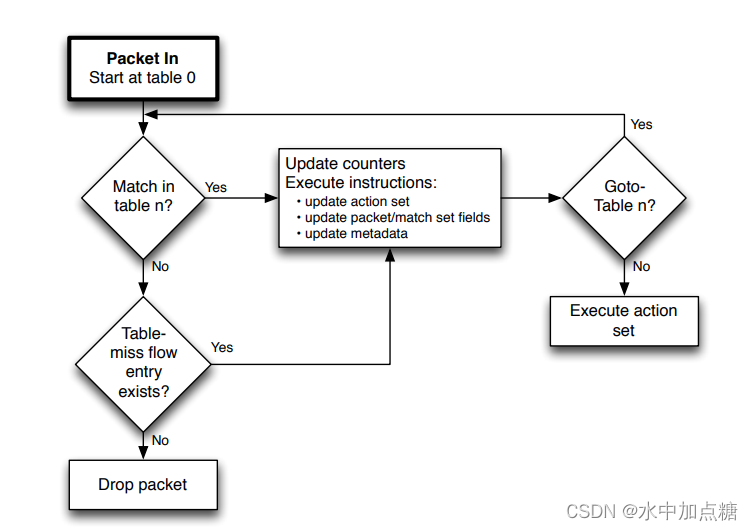
交换机的表项有了之后,再根据流表的匹配过程进行匹配最终会将arp包发送到控制器,抓包验证一下:
tcpdump -i any port 6633 -w /home/6633.pcap
使用wireshark打开看一下,可看到h1一直在发广播arp包,targetIp为h2的ip。

host学习机制
上面说到h1所发送的arp包将会到达控制器。当控制器收到数据包后将会由onos中的PacetManager进行分发处理,其中与arp包息息相关的包处理器有两个,分别为:
NeighbourResolutionManager和HostLocationProvider中的InternalHostProvider,这里主要探究一下后者。

在org.onosproject.provider.host.impl.HostLocationProvider中注册了一个高优先级type为advisor的packetProcessor
顺便提一下onos中packetProcessor两个type的区别:
Advisor 主要用于监视和分析数据包,但不会阻止或修改数据包的流向。
Director 允许处理器在处理数据包时对其进行修改,并且可以决定是否阻止数据包的流动。
private final InternalHostProvider processor = new InternalHostProvider();
@Activate
public void activate(ComponentContext context) {
……
packetService.addProcessor(processor, PacketProcessor.advisor(1));
deviceService.addListener(deviceListener);
……
log.info("Started with Application ID {}", appId.id());
}
当收到一个packet时,HostLocationProvider中的process方法会解析出包的信息并根据情况更新host的信息,代码片段如下:
@Override
public void process(PacketContext context) {
// Verify valid context
if (context == null) {
return;
}
// Verify valid Ethernet packet
Ethernet eth = context.inPacket().parsed();
if (eth == null) {
return;
}
// Dispatch to a worker thread
HostId hostId = HostId.hostId(eth.getSourceMAC(), VlanId.vlanId(eth.getVlanID()));
packetWorkers.execute(() -> processPacketInternal(context), hostId.hashCode());
}
private void processPacketInternal(PacketContext context) {
Ethernet eth = context.inPacket().parsed();
MacAddress srcMac = eth.getSourceMAC();
if (srcMac.isBroadcast() || srcMac.isMulticast()) {
return;
}
VlanId vlan = VlanId.vlanId(eth.getVlanID());
VlanId outerVlan = VlanId.vlanId(eth.getQinQVID());
VlanId innerVlan = VlanId.NONE;
EthType outerTpid = EthType.EtherType.UNKNOWN.ethType();
// Set up values for double-tagged hosts
if (outerVlan.toShort() != Ethernet.VLAN_UNTAGGED) {
innerVlan = vlan;
vlan = outerVlan;
outerTpid = EthType.EtherType.lookup(eth.getQinQTPID()).ethType();
}
ConnectPoint heardOn = context.inPacket().receivedFrom();
// If this arrived on control port, bail out.
if (heardOn.port().isLogical()) {
return;
}
// If this is not an edge port, bail out.
Topology topology = topologyService.currentTopology();
if (topologyService.isInfrastructure(topology, heardOn)) {
return;
}
HostLocation hloc = new HostLocation(heardOn, System.currentTimeMillis());
HostId hid = HostId.hostId(eth.getSourceMAC(), vlan);
MacAddress destMac = eth.getDestinationMAC();
// Ignore location probes
if (multihomingEnabled && destMac.isOnos() && !MacAddress.NONE.equals(destMac)) {
return;
}
HostLearningConfig cfg = netcfgService.getConfig(heardOn, HostLearningConfig.class);
// if learning is disabled bail out.
if ((cfg != null) && (!cfg.hostLearningEnabled())) {
log.debug("Learning disabled for {}, abort.", heardOn);
return;
}
// ARP: possible new hosts, update both location and IP
if (eth.getEtherType() == Ethernet.TYPE_ARP) {
ARP arp = (ARP) eth.getPayload();
IpAddress ip = IpAddress.valueOf(IpAddress.Version.INET,
arp.getSenderProtocolAddress());
createOrUpdateHost(hid, srcMac, vlan, innerVlan, outerTpid, hloc, ip);
// IPv4: update location only
} else if (eth.getEtherType() == Ethernet.TYPE_IPV4) {
// Update host location
createOrUpdateHost(hid, srcMac, vlan, innerVlan, outerTpid, hloc, null);
if (useDhcp) {
DHCP dhcp = findDhcp(eth).orElse(null);
// DHCP ACK: additionally update IP of DHCP client
if (dhcp != null && dhcp.getPacketType().equals(DHCP.MsgType.DHCPACK)) {
MacAddress hostMac = MacAddress.valueOf(dhcp.getClientHardwareAddress());
VlanId hostVlan = VlanId.vlanId(eth.getVlanID());
HostId hostId = HostId.hostId(hostMac, hostVlan);
updateHostIp(hostId, IpAddress.valueOf(dhcp.getYourIPAddress()));
}
}
// NeighborAdvertisement and NeighborSolicitation: possible
// new hosts, update both location and IP.
//
// IPv6: update location only
} else if (eth.getEtherType() == Ethernet.TYPE_IPV6) {
……
//process ipv6
……
}
}
上面方法中会对包进行解包,提取出包的mac地址、ip、vlan等信息,最终并调用createOrUpdateHost方法对host的信息进行更新
/**
* Create or update host information.
* Will not update IP if IP is null, all zero or self-assigned.
*
* @param ip source IP address or null if not updating
*/
private void createOrUpdateHost(HostId hid, MacAddress mac, VlanId vlan,
VlanId innerVlan, EthType outerTpid,
HostLocation hloc, IpAddress ip) {
log.debug("Creating Host {} based on Location {}", hid, hloc);
Set<HostLocation> newLocations = Sets.newHashSet(hloc);
……
HostDescription desc = ip == null || ip.isZero() || ip.isSelfAssigned() ?
new DefaultHostDescription(mac, vlan, newLocations, Sets.newHashSet(),
innerVlan, outerTpid, false) :
new DefaultHostDescription(mac, vlan, newLocations, Sets.newHashSet(ip),
innerVlan, outerTpid, false);
try {
providerService.hostDetected(hid, desc, false);
} catch (IllegalStateException e) {
log.debug("Host {} suppressed", hid);
}
}
/** Enable/Disable tracking of rogue host moves. */
private boolean hostMoveTrackerEnabled = HM_HOST_MOVE_TRACKER_ENABLE_DEFAULT;
public static final boolean HM_HOST_MOVE_TRACKER_ENABLE_DEFAULT = false;
@Override
public void hostDetected(HostId hostId, HostDescription initialHostDescription, boolean replaceIps) {
log.debug("Host Detected {}, {}", hostId, initialHostDescription);
HostDescription hostDescription = initialHostDescription;
checkNotNull(hostId, HOST_ID_NULL);
checkValidity();
…………
if (!allowDuplicateIps) {
removeDuplicates(hostId, hostDescription);
}
if (!hostMoveTrackerEnabled) {
store.createOrUpdateHost(provider().id(), hostId,
hostDescription, replaceIps);
}
…………
}
Host更新时机
需要注意的是,不是每次有arp包发往了控制器都要对onos中的host进行更新,是否需要更新host由其中的shouldUpdate方法决定,代码如下:
@Override
public HostEvent createOrUpdateHost(ProviderId providerId,
HostId hostId,
HostDescription hostDescription,
boolean replaceIPs) {
hostsConsistentMap.computeIf(hostId,
existingHost -> shouldUpdate(existingHost, providerId,
hostDescription, replaceIPs),
(id, existingHost) -> {
final Set<IpAddress> addresses;
if (existingHost == null || replaceIPs) {
//ip覆盖
addresses = ImmutableSet.copyOf(hostDescription.ipAddress());
} else {
//ip累加
addresses = Sets.newHashSet(existingHost.ipAddresses());
addresses.addAll(hostDescription.ipAddress());
}
final Annotations annotations;
if (existingHost != null) {
annotations = merge((DefaultAnnotations) existingHost.annotations(),
hostDescription.annotations());
} else {
annotations = hostDescription.annotations();
}
return new DefaultHost(providerId,
hostId,
hostDescription.hwAddress(),
hostDescription.vlan(),
hostDescription.locations(),
hostDescription.auxLocations(),
addresses,
hostDescription.innerVlan(),
hostDescription.tpid(),
hostDescription.configured(),
false,
annotations);
});
return null;
}
private boolean shouldUpdate(DefaultHost existingHost,
ProviderId providerId,
HostDescription hostDescription,
boolean replaceIPs) {
if (existingHost == null) {
return true;
}
// Avoid overriding configured host with learnt host
if (existingHost.configured() && !hostDescription.configured()) {
return false;
}
if (!Objects.equals(existingHost.providerId(), providerId) ||
!Objects.equals(existingHost.mac(), hostDescription.hwAddress()) ||
!Objects.equals(existingHost.vlan(), hostDescription.vlan()) ||
!Objects.equals(existingHost.innerVlan(), hostDescription.innerVlan()) ||
!Objects.equals(existingHost.tpid(), hostDescription.tpid()) ||
!Objects.equals(existingHost.locations(), hostDescription.locations()) ||
!Objects.equals(existingHost.auxLocations(), hostDescription.auxLocations())) {
return true;
}
if (replaceIPs) {
if (!Objects.equals(hostDescription.ipAddress(),
existingHost.ipAddresses())) {
return true;
}
} else {
if (!existingHost.ipAddresses().containsAll(hostDescription.ipAddress())) {
return true;
}
}
// check to see if any of the annotations provided by hostDescription
// differ from those in the existing host
return hostDescription.annotations().keys().stream()
.anyMatch(k -> !Objects.equals(hostDescription.annotations().value(k),
existingHost.annotations().value(k)));
}
HostEvent
host信息的存储使用DistributedHostStore进行实现,每次host的更新会触发相应的hostEvent,实现代码位于org.onosproject.store.host.impl.HostLocationTracker中,主要片段如下:
private class HostLocationTracker implements MapEventListener<HostId, DefaultHost> {
@Override
public void event(MapEvent<HostId, DefaultHost> event) {
DefaultHost host = Versioned.valueOrNull(event.newValue());
DefaultHost prevHost = Versioned.valueOrNull(event.oldValue());
switch (event.type()) {
case INSERT:
updateHostsByIp(host, prevHost);
notifyDelegate(new HostEvent(HOST_ADDED, host));
break;
case UPDATE:
updateHostsByIp(host, prevHost);
if (host.suspended() && !prevHost.suspended()) {
notifyDelegate(new HostEvent(HOST_SUSPENDED, host, prevHost));
} else if (!host.suspended() && prevHost.suspended()) {
notifyDelegate(new HostEvent(HOST_UNSUSPENDED, host, prevHost));
} else if (!Objects.equals(prevHost.locations(), host.locations())) {
//连接设备或端口变更,触发HOST_MOVED
notifyDelegate(new HostEvent(HOST_MOVED, host, prevHost));
} else if (!Objects.equals(prevHost.auxLocations(), host.auxLocations())) {
notifyDelegate(new HostEvent(HOST_AUX_MOVED, host, prevHost));
} else if (!Objects.equals(prevHost, host)) {
//host其他信息不一致,触发HOST_UPDATED
notifyDelegate(new HostEvent(HOST_UPDATED, host, prevHost));
}
break;
case REMOVE:
removeHostsByIp(prevHost);
notifyDelegate(new HostEvent(HOST_REMOVED, prevHost));
break;
default:
log.warn("Unknown map event type: {}", event.type());
}
}
}
private void updateHostsByIp(DefaultHost host, DefaultHost prevHost) {
// Let's update first the current ips
host.ipAddresses().forEach(
ip -> hostsByIp.compute(ip, (k, v) -> v == null ? addHosts(host) : updateHosts(v, host)));
// Let's remove then each old ip
Set<IpAddress> oldIps = prevHost != null ? prevHost.ipAddresses() : Collections.emptySet();
Sets.difference(oldIps, host.ipAddresses()).forEach(
ip -> hostsByIp.computeIfPresent(ip, (k, v) -> removeHosts(v, host)));
}
private Set<Host> addHosts(Host host) {
Set<Host> hosts = Sets.newConcurrentHashSet();
hosts.add(host);
return hosts;
}
private Set<Host> updateHosts(Set<Host> existingHosts, Host host) {
existingHosts.removeIf(existingHost -> existingHost.id().equals(host.id()));
existingHosts.add(host);
return existingHosts;
}
以上代码便是host学习机制的核心代码了。
了解了这些知识后,我们便知道:当控制器收到arp包后会产生出对应的host进行存储到onos中,如需查看可使用hosts命令:

onos@root > hosts
id=AA:5A:21:9C:1B:34/None, mac=AA:5A:21:9C:1B:34, locations=[of:0000000000000001/1], auxLocations=null, vlan=None, ip(s)=[10.0.0.1], innerVlan=None, outerTPID=unknown, provider=of:org.onosproject.provider.host, configured=false
如上所示,便显示出了host1的关键信息,如所连设备的port、ip、vlan、mac信息一目了然。
初始表项下发原理
上面带大家一起过了下host学习机制的过程,这里再一起过一下初始表项下发的具体细节。
下发的代码详细位置可通过openflow应用源码中寻找:
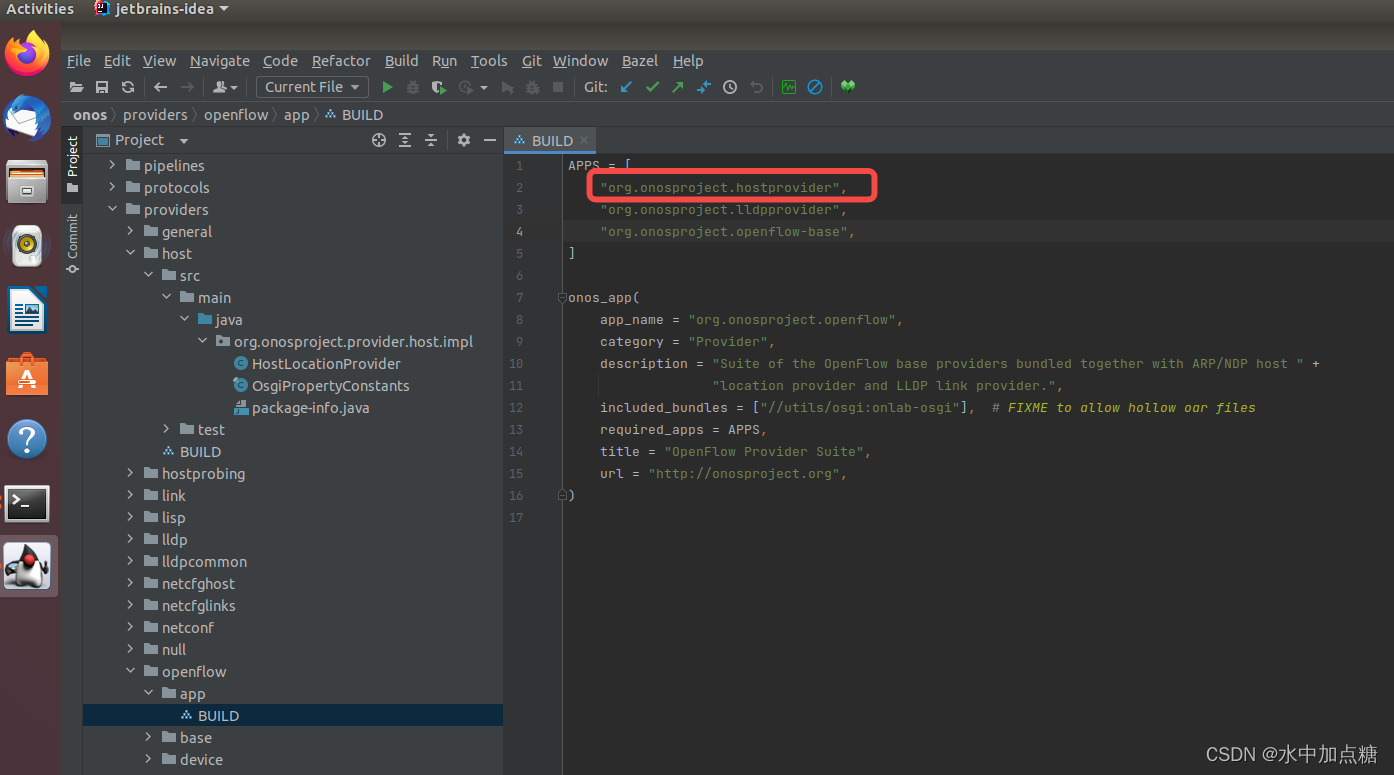
下发arp表项的代码位于 org.onosproject.provider.host.impl.HostLocationProvider#requestIntercepts() 方法中

主要代码为:
…………
/** Request ARP packets for neighbor discovery by the Host Location Provider; default is true. */
private boolean requestArp = true;
/** Requests IPv6 NDP Neighbor Solicitation and Advertisement by the Host Location Provider; default is false. */
private boolean requestIpv6ND = false;
/** Requests IPv6 NDP Router Solicitation and Advertisement by the Host Location Provider; default is false. */
private boolean requestIpv6NdpRsRa = false;
…………
/**
* Request packet intercepts.
*/
private void requestIntercepts() {
// Use ARP
TrafficSelector.Builder selector = DefaultTrafficSelector.builder()
.matchEthType(Ethernet.TYPE_ARP);
if (requestArp) {
packetService.requestPackets(selector.build(), PacketPriority.CONTROL, appId);
} else {
packetService.cancelPackets(selector.build(), PacketPriority.CONTROL, appId);
}
// Use IPv6 NDP Neighbor Solicitation and Advertisement
selector.matchEthType(Ethernet.TYPE_IPV6)
.matchIPProtocol(IPv6.PROTOCOL_ICMP6);
if (requestIpv6ND) {
selector.matchIcmpv6Type(ICMP6.NEIGHBOR_SOLICITATION);
packetService.requestPackets(selector.build(), PacketPriority.CONTROL, appId);
selector.matchIcmpv6Type(ICMP6.NEIGHBOR_ADVERTISEMENT);
packetService.requestPackets(selector.build(), PacketPriority.CONTROL, appId);
} else {
selector.matchIcmpv6Type(ICMP6.NEIGHBOR_SOLICITATION);
packetService.cancelPackets(selector.build(), PacketPriority.CONTROL, appId);
selector.matchIcmpv6Type(ICMP6.NEIGHBOR_ADVERTISEMENT);
packetService.cancelPackets(selector.build(), PacketPriority.CONTROL, appId);
}
// Use IPv6 NDP Router Solicitation and Advertisement
if (requestIpv6NdpRsRa) {
selector.matchIcmpv6Type(ICMP6.ROUTER_SOLICITATION);
packetService.requestPackets(selector.build(), PacketPriority.CONTROL, appId);
selector.matchIcmpv6Type(ICMP6.ROUTER_ADVERTISEMENT);
packetService.requestPackets(selector.build(), PacketPriority.CONTROL, appId);
} else {
selector.matchIcmpv6Type(ICMP6.ROUTER_SOLICITATION);
packetService.cancelPackets(selector.build(), PacketPriority.CONTROL, appId);
selector.matchIcmpv6Type(ICMP6.ROUTER_ADVERTISEMENT);
packetService.cancelPackets(selector.build(), PacketPriority.CONTROL, appId);
}
}
下发的过程为使用requestPackets的方式进行实现,在onos中可以使用如下命令查看期望下发的表项信息
packet-requests
org.onosproject.net.packet.impl.PacketManager.InternalDeviceListener#event() 负责设备可用时对packet-requests的流表进行下发。
当某种类似的设备接入onos时需要在onos/drivers/default/src/main/resources/onos-drivers.xml中定义各自的drivier信息,如ovs交换机定义了supportPacketRequest的属性为true,代表启用packetRequest。
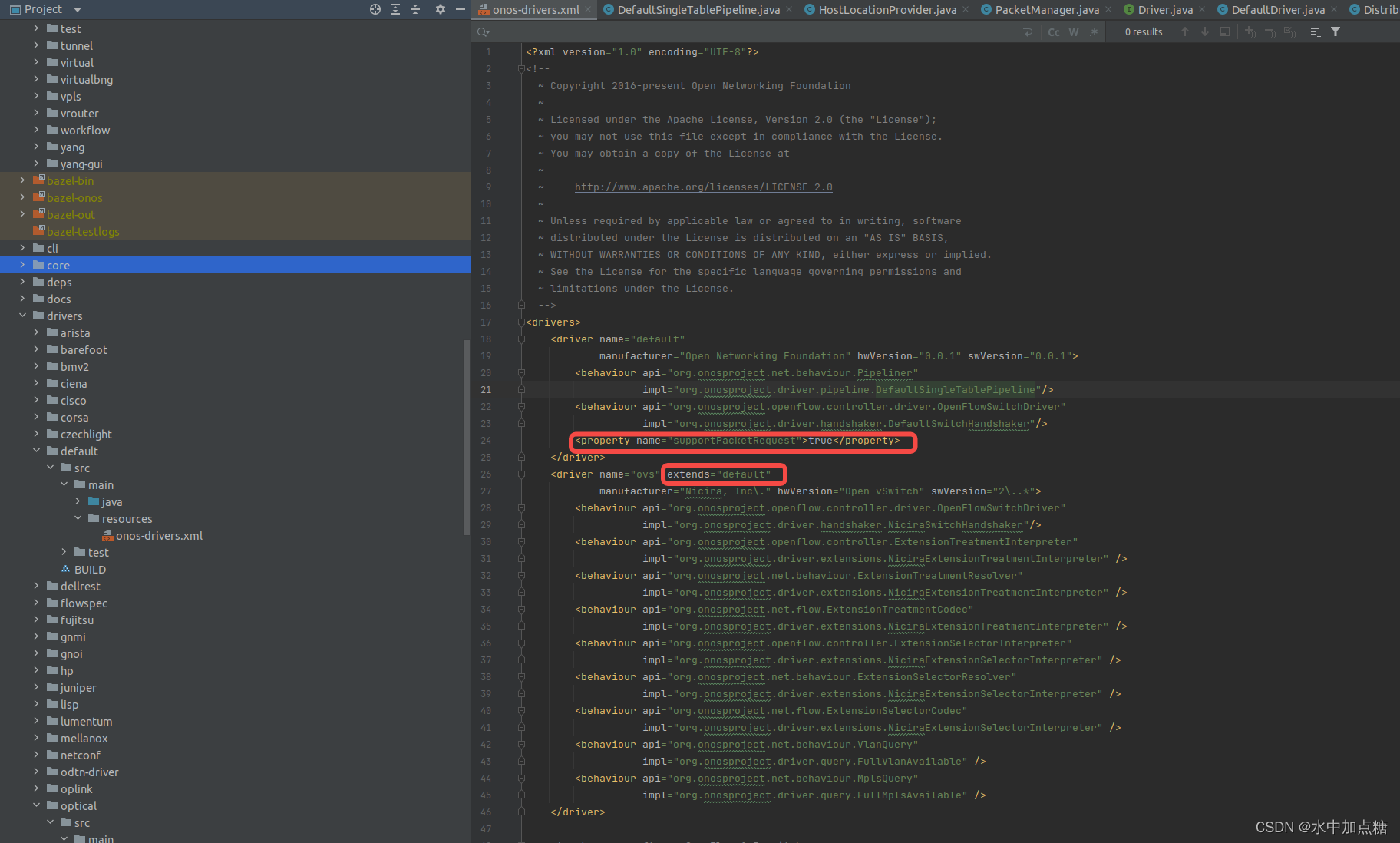
这里许多实现细节不详细展开,对于openflow设备而言可查看DefaultSingleTablePipeline.forward方法,方法如下:
@Override
public void forward(ForwardingObjective fwd) {
TrafficSelector selector = fwd.selector();
if (fwd.treatment() != null) {
// Deal with SPECIFIC and VERSATILE in the same manner.
FlowRule.Builder ruleBuilder = DefaultFlowRule.builder()
.forDevice(deviceId)
.withSelector(selector)
.fromApp(fwd.appId())
.withPriority(fwd.priority())
.withTreatment(fwd.treatment());
if (fwd.permanent()) {
ruleBuilder.makePermanent();
} else {
ruleBuilder.makeTemporary(fwd.timeout());
}
installObjective(ruleBuilder, fwd);
} else {
NextObjective nextObjective;
NextGroup next;
TrafficTreatment treatment;
if (fwd.op() == ADD) {
// Give a try to the cache. Doing an operation
// on the store seems to be very expensive.
nextObjective = pendingAddNext.getIfPresent(fwd.nextId());
// If the next objective is not present
// We will try with the store
if (nextObjective == null) {
next = flowObjectiveStore.getNextGroup(fwd.nextId());
// We verify that next was in the store and then de-serialize
// the treatment in order to re-build the flow rule.
if (next == null) {
fwd.context().ifPresent(c -> c.onError(fwd, ObjectiveError.GROUPMISSING));
return;
}
treatment = appKryo.deserialize(next.data());
} else {
pendingAddNext.invalidate(fwd.nextId());
treatment = getTreatment(nextObjective);
if (treatment == null) {
fwd.context().ifPresent(c -> c.onError(fwd, ObjectiveError.UNSUPPORTED));
return;
}
}
} else {
// We get the NextGroup from the remove operation.
// Doing an operation on the store seems to be very expensive.
next = flowObjectiveStore.getNextGroup(fwd.nextId());
treatment = (next != null) ? appKryo.deserialize(next.data()) : null;
}
// If the treatment is null we cannot re-build the original flow
if (treatment == null) {
fwd.context().ifPresent(c -> c.onError(fwd, ObjectiveError.GROUPMISSING));
return;
}
// Finally we build the flow rule and push to the flow rule subsystem.
FlowRule.Builder ruleBuilder = DefaultFlowRule.builder()
.forDevice(deviceId)
.withSelector(selector)
.fromApp(fwd.appId())
.withPriority(fwd.priority())
.withTreatment(treatment);
if (fwd.permanent()) {
ruleBuilder.makePermanent();
} else {
ruleBuilder.makeTemporary(fwd.timeout());
}
installObjective(ruleBuilder, fwd);
}
}
private void installObjective(FlowRule.Builder ruleBuilder, Objective objective) {
FlowRuleOperations.Builder flowBuilder = FlowRuleOperations.builder();
switch (objective.op()) {
case ADD:
flowBuilder.add(ruleBuilder.build());
break;
case REMOVE:
flowBuilder.remove(ruleBuilder.build());
break;
default:
log.warn("Unknown operation {}", objective.op());
}
flowRuleService.apply(flowBuilder.build(new FlowRuleOperationsContext() {
@Override
public void onSuccess(FlowRuleOperations ops) {
objective.context().ifPresent(context -> context.onSuccess(objective));
}
@Override
public void onError(FlowRuleOperations ops) {
objective.context()
.ifPresent(context -> context.onError(objective, ObjectiveError.FLOWINSTALLATIONFAILED));
}
}));
}
从上面可以看出openflow-driver最终执行的flowRuleService的apply方法对packet-requests所需要的表项进行了下发。
ipv4-ping通
继续上文中,以上面的h1 ping h2为例,梳理一下流程:
- h1 ping h2,h1不知道h2的mac,发送arp到交换机
- 交换机收到h1发来的arp,匹配arp表项将包packetIn到controller
- controller收到s1发来的arp包,解析arp包中的信息并记录h1的host信息(ip、mac、vlan、connectPoint)
然后就没有然后了,抓包也看到了arp包到达控制器之后就没有再次转发了。
如何解决?有两种方式:
- 手动下发表项,将所有h1所连口的包直接转到h2所连的口(不灵活,太具有局限性)
- 将数据包转由控制器来控制,到达控制器的数据包根据代码逻辑进行转发
那么代码要具体怎么写呢?很巧,这些都由onos自带的fwd应用实现了。如仅想让ipv4能ping通直接启动它即可。启动命令如下:
app activate org.onosproject.fwd
启动好了之后再ping一下

ping成功了。拓扑图也有了变化,两个主机信息都展示在了界面中。

再整理一下两个主机发送arp与ping包的过程,时序图画起来:
arp包转发过程

结合抓包一起看一下:

如想要了解arp回包的详细过程,onos中也提供了ArpProxy应用可实现代理回包。
应用包名为:org.onosproject.proxyarp
其主要原理是利用系统中自带的NeighbourResolutionManager实现的,如想要自行实现一套自己arp/ndp回包机制了解其中的代码具有一定的帮助。
icmp包转发过程

icmp包抓包信息:
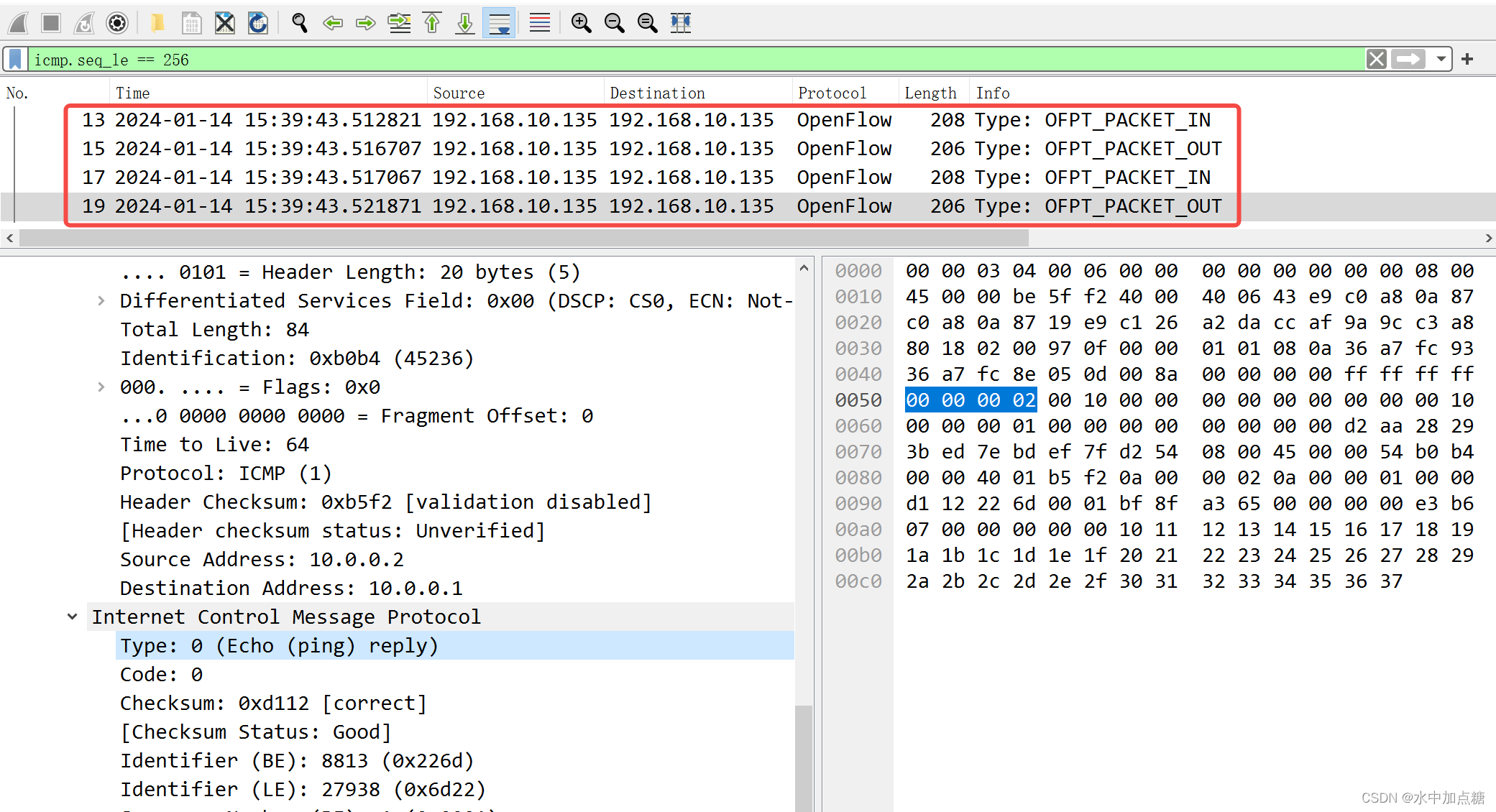
fwd应用包处理过程
通过前面的步骤,目前我们已经完成了同一个设备下不同主机间的通信,现在再来看一下fwd应用具体是如何实现的。
直接查看org.onosproject.fwd.ReactiveForwarding内部类:ReactivePacketProcessor

查看它的process方法:
public void process(PacketContext context) {
// Stop processing if the packet has been handled, since we
// can't do any more to it.
if (context.isHandled()) {
return;
}
InboundPacket pkt = context.inPacket();
Ethernet ethPkt = pkt.parsed();
……
HostId id = HostId.hostId(ethPkt.getDestinationMAC(), VlanId.vlanId(ethPkt.getVlanID()));
……
// Do we know who this is for? If not, flood and bail.
Host dst = hostService.getHost(id);
if (dst == null) {
flood(context, macMetrics);
return;
}
// Are we on an edge switch that our destination is on? If so,
// simply forward out to the destination and bail.
if (pkt.receivedFrom().deviceId().equals(dst.location().deviceId())) {
if (!context.inPacket().receivedFrom().port().equals(dst.location().port())) {
installRule(context, dst.location().port(), macMetrics);
}
return;
}
……
// Otherwise forward and be done with it.
installRule(context, path.src().port(), macMetrics);
}
// Install a rule forwarding the packet to the specified port.
private void installRule(PacketContext context, PortNumber portNumber, ReactiveForwardMetrics macMetrics) {
//
// We don't support (yet) buffer IDs in the Flow Service so
// packet out first.
//
Ethernet inPkt = context.inPacket().parsed();
TrafficSelector.Builder selectorBuilder = DefaultTrafficSelector.builder();
// If PacketOutOnly or ARP packet than forward directly to output port
if (packetOutOnly || inPkt.getEtherType() == Ethernet.TYPE_ARP) {
packetOut(context, portNumber, macMetrics);
return;
}
//
// If matchDstMacOnly
// Create flows matching dstMac only
// Else
// Create flows with default matching and include configured fields
//
if (matchDstMacOnly) {
selectorBuilder.matchEthDst(inPkt.getDestinationMAC());
} else {
selectorBuilder.matchInPort(context.inPacket().receivedFrom().port())
.matchEthSrc(inPkt.getSourceMAC())
.matchEthDst(inPkt.getDestinationMAC());
// If configured Match Vlan ID
if (matchVlanId && inPkt.getVlanID() != Ethernet.VLAN_UNTAGGED) {
selectorBuilder.matchVlanId(VlanId.vlanId(inPkt.getVlanID()));
}
……
}
TrafficTreatment treatment;
if (inheritFlowTreatment) {
treatment = context.treatmentBuilder()
.setOutput(portNumber)
.build();
} else {
treatment = DefaultTrafficTreatment.builder()
.setOutput(portNumber)
.build();
}
ForwardingObjective forwardingObjective = DefaultForwardingObjective.builder()
.withSelector(selectorBuilder.build())
.withTreatment(treatment)
.withPriority(flowPriority)
.withFlag(ForwardingObjective.Flag.VERSATILE)
.fromApp(appId)
.makeTemporary(flowTimeout)
.add();
flowObjectiveService.forward(context.inPacket().receivedFrom().deviceId(),
forwardingObjective);
forwardPacket(macMetrics);
//
// If packetOutOfppTable
// Send packet back to the OpenFlow pipeline to match installed flow
// Else
// Send packet direction on the appropriate port
//
if (packetOutOfppTable) {
packetOut(context, PortNumber.TABLE, macMetrics);
} else {
packetOut(context, portNumber, macMetrics);
}
}
咱们先只关注arp与imcp包的处理流程:对于未学到目的ip的host,arp包将进行arp泛洪
// Do we know who this is for? If not, flood and bail.
Host dst = hostService.getHost(id);
if (dst == null) {
flood(context, macMetrics);
return;
}
private void flood(PacketContext context, ReactiveForwardMetrics macMetrics) {
if (topologyService.isBroadcastPoint(topologyService.currentTopology(),
context.inPacket().receivedFrom())) {
packetOut(context, PortNumber.FLOOD, macMetrics);
} else {
context.block();
}
}
对于icmp包,将解析出目的mac地址并查询出目的host信息,并将icmp包直接转发至对端主机。同时为了避免每次都将包转发给控制器,还会下发超时时间为10秒的表项,这样以达到性能最佳。
处理icmp包时控制器上设备所拥有的表项如下:

与设备上的流表也对比一下

ipv6-ping通
上面我们一起将同一个交换机下的3台主机ping通了,都用上SDN中ipv6是必不可少的。最后再将h1和h2配置上ipv6地址让它们也能用ipv6地址通信。
前面启动的mininet默认不会给host配置ipv6地址,需要手动配置一下,直接在mininet的命令行中操作:
#配置ipv6地址
h1 ip addr add 2001::1/64 dev h1-eth0
h2 ip addr add 2001::2/64 dev h2-eth0
配置好后试一下h1 ping6 h2能否ping通
h1 ping6 2001::2 -c 3
不出意外的话,第一次ping失败了。
分析原因:与ipv4类似的,在同一个二层域中的ipv6主机进行通信仍然使用mac进行通信,初步判断为仍然没有学到对端的mac地址。
在mininet中用ip neighbor查看一下

猜想正确,h1的邻居表中没有h2的ipv6地址对应的mac地址,ipv6时发icmpv6包之前则会发送NDP包以获取h2的mac信息。
查看一下当前设备表项:
dpctl dump-flows
查看表项没有看到对ipv6处理的表项。根据前面对openflow的了解,我们知道如果想要处理ipv6类似的包是需要给设备下对应的ipv6表项的。
在翻看fwd应用源码和配置时看到其中有这样一条配置:
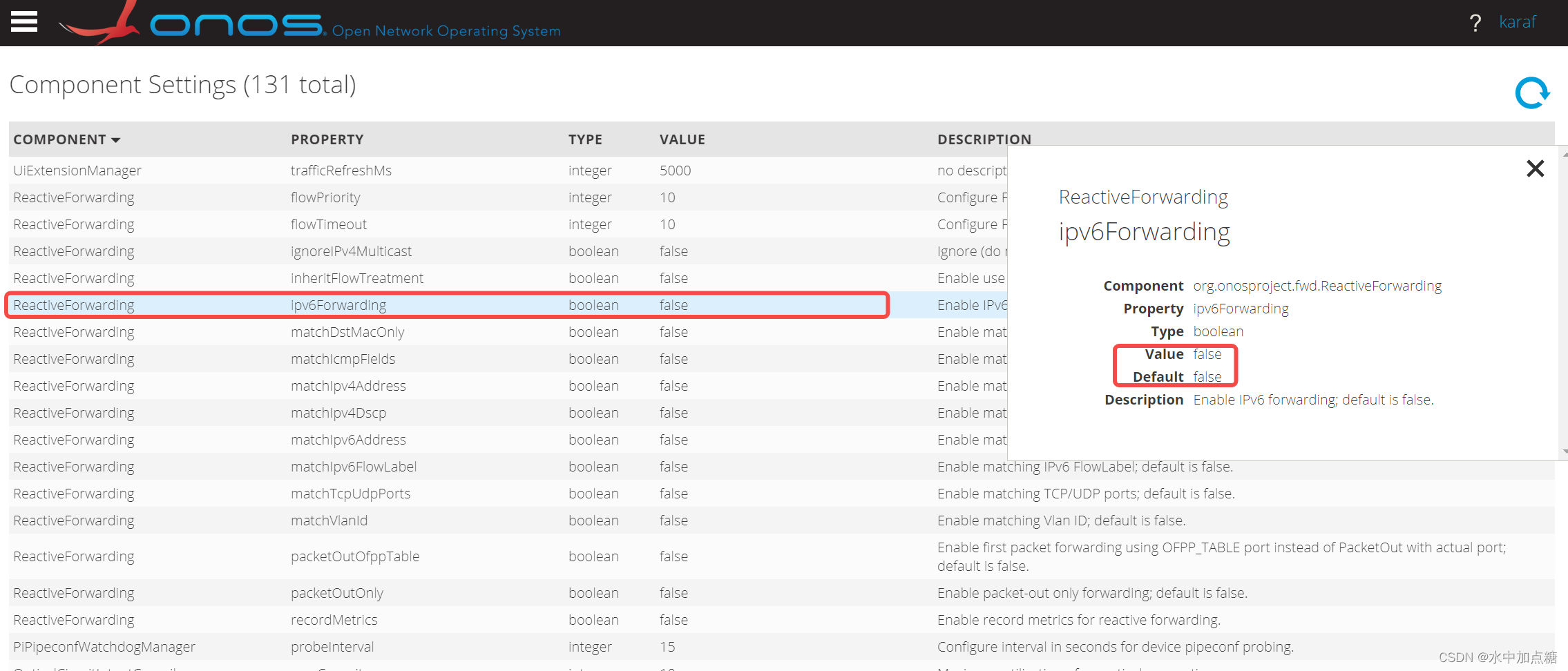
ReactiveForwarding下的ipv6Forwarding默认处于关闭状态,则代表默认不转发ipv6数据包。咱们将其打开即可,控制器的控制台中输入以下命令即可:
cfg set org.onosproject.fwd.ReactiveForwarding ipv6Forwarding true
再次查看表项,发现立马多了转发ipv6的表项。

再ping6试一下,ipv6下也ping成功了

查看h1和h2的邻居信息,都学到了对端的MAC

结合抓包再看一下:
NS包

NA包

ICMPV6-request
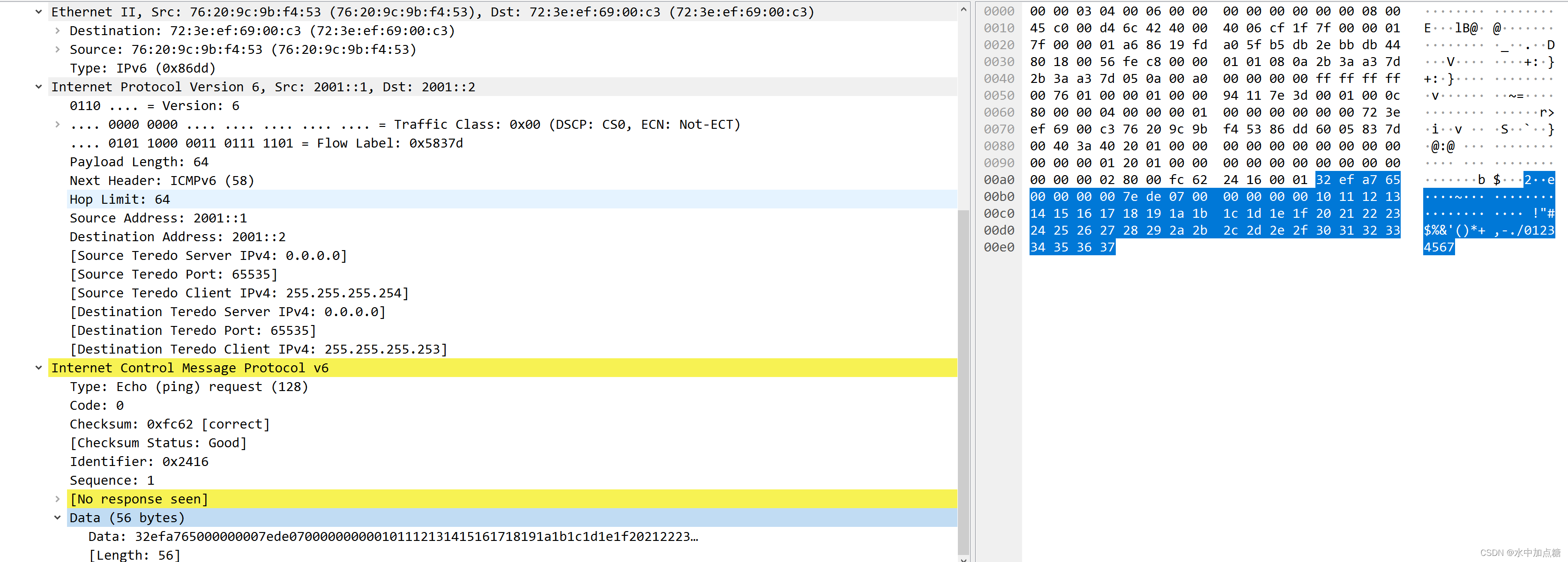
ICMPV6-reply

最终ONOS控制器上的拓扑图如下:

fwd关于ipv6部分转发的源码与前面ipv4部分的结构大体类似,感觉还是挺不错的。
本文来自互联网用户投稿,该文观点仅代表作者本人,不代表本站立场。本站仅提供信息存储空间服务,不拥有所有权,不承担相关法律责任。 如若内容造成侵权/违法违规/事实不符,请联系我的编程经验分享网邮箱:chenni525@qq.com进行投诉反馈,一经查实,立即删除!
- Python教程
- 深入理解 MySQL 中的 HAVING 关键字和聚合函数
- Qt之QChar编码(1)
- MyBatis入门基础篇
- 用Python脚本实现FFmpeg批量转换
- Mac book air 重新安装系统验证显示 untrusted_cert_title
- UDP 和 TCP 、HTTP、HTTPS、SOCKS5协议的不同之处及应用场景
- 【代码片段】Linux C++打印当前函数调用堆栈
- 算法——贪心法(Greedy)
- 嵌入式-Stm32-江科大基于标准库的GPIO通用输入输出口
- ERA5合集,使用ERA5得到GNSS站点的温度,气压,水汽压,Tm和PWV合集,可以求五个参数
- 51单片机的中断相关知识
- 重组蛋白表达纯化--卡梅德生物
- 实现单链表的基本操作(力扣、牛客刷题的基础&笔试题常客)
- 持续领先 | 开源网安连续三年上榜ISC数字安全创新能力百强



